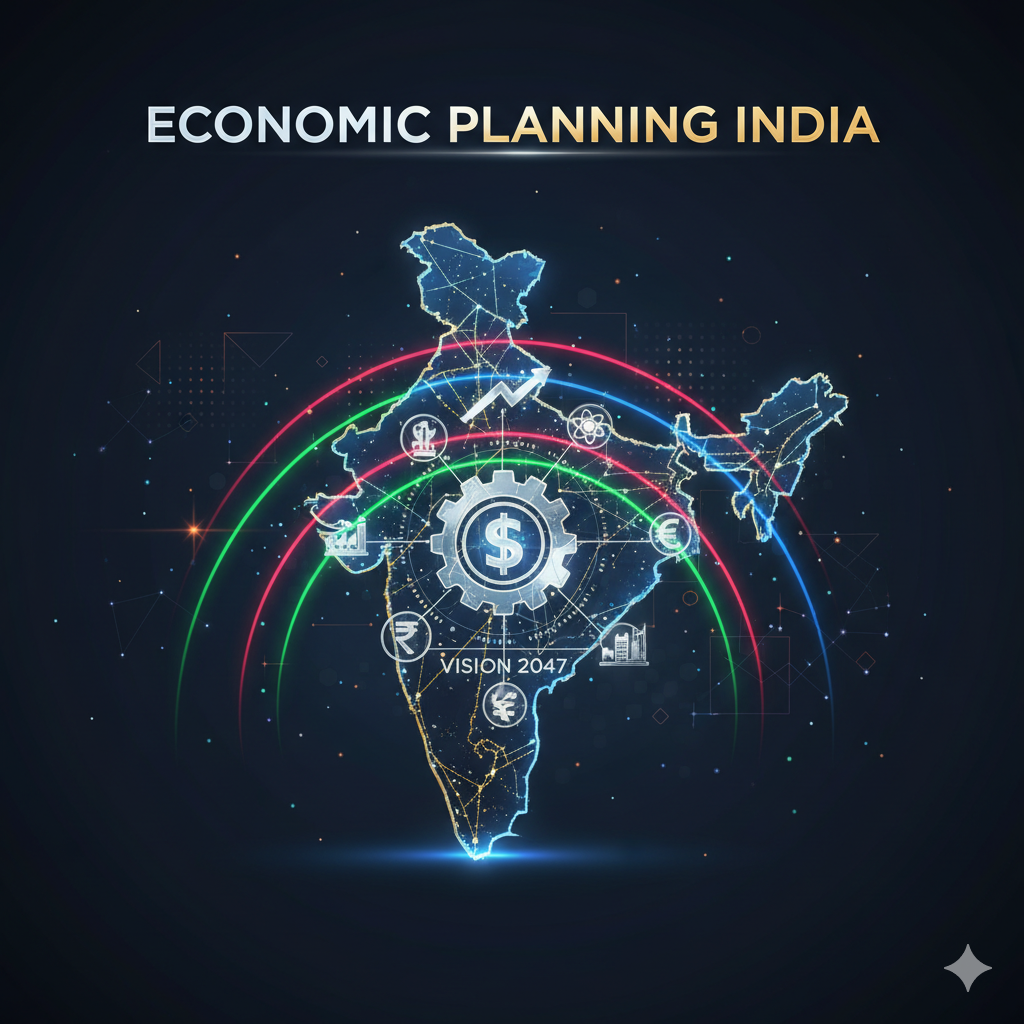Introduction
Economic planning has been a cornerstone of India’s developmental journey since independence. When India gained freedom in 1947, it faced widespread poverty, low per capita income, unemployment, underdeveloped industries, and stagnant agriculture. To overcome these structural challenges, India adopted the model of planned economic development, inspired by socialist ideas and the success of the Soviet Union’s five-year plans. Economic planning in India became a deliberate effort by the state to allocate resources efficiently, promote industrial growth, ensure social justice, and achieve balanced regional development.
Meaning of Economic Planning
Economic planning refers to the systematic and deliberate process of allocating a nation’s resources—human, natural, and capital—towards achieving specific developmental goals within a defined time frame. In simpler terms, it means deciding in advance what, how, and for whom to produce, guided by national objectives rather than market forces alone.
Definition of Economic Planning
- Prof. Lewis defines economic planning as “conscious and deliberate choice of economic priorities by some public authority.”
- D.R. Gadgil describes it as “a technique of economic management which utilizes the resources of a country to achieve certain predetermined objectives within a specified time frame.”
Thus, economic planning involves setting targets, mobilizing resources, and implementing policies to achieve economic growth, social equity, and national self-reliance.
Features of Economic Planning
- Goal-oriented approach – Plans are formulated to achieve specific economic and social objectives.
- Government-led development – The state plays a central role in resource allocation and policy implementation.
- Time-bound targets – Every plan operates within a specific time period, such as a Five-Year Plan.
- Resource optimization – It ensures maximum utilization of available resources with minimal wastage.
- Flexibility – Plans are periodically reviewed and adjusted according to changing needs.
- Comprehensive scope – It covers all sectors—agriculture, industry, services, infrastructure, and social development.
Objectives of Economic Planning in India
Economic planning in India has been guided by multiple interrelated objectives. The main goal has always been to promote economic growth with social justice. Over time, these objectives have evolved with the changing socio-economic context.
1. Economic Growth
The primary objective of planning is to increase the national income and achieve higher economic growth rates. Growth helps in raising living standards, creating employment, and generating resources for social development. India’s early plans targeted growth through rapid industrialization, while later plans emphasized inclusive and sustainable growth.
2. Employment Generation
High unemployment and underemployment were major challenges after independence. Hence, every plan aimed to create more job opportunities, especially in rural areas through agricultural development, small-scale industries, and public works programs like MGNREGA in later years.
3. Reduction of Inequality
India’s planning strategy aimed to reduce income and wealth inequalities among different social groups and regions. Progressive taxation, land reforms, and social welfare programs were used to ensure equitable distribution of income.
4. Poverty Alleviation
Eradication of poverty has remained a constant objective since the 4th Five-Year Plan. Programs like Integrated Rural Development Programme (IRDP), Rural Employment Guarantee Scheme, and later poverty-focused initiatives have been part of the planning framework.
5. Self-Reliance
Another significant goal was to reduce dependence on foreign aid and imports by strengthening domestic industries and technology. Self-reliance became a key slogan during the 1970s, particularly in the context of the Green Revolution and import substitution industrialization.
6. Modernization of the Economy
Planning also aimed at modernizing agriculture, industry, and infrastructure by introducing advanced technologies, improving productivity, and building skilled manpower.
7. Balanced Regional Development
Economic planning sought to bridge the regional disparities between developed and underdeveloped states through special programs like the Backward Regions Grant Fund (BRGF) and industrial corridor development.
8. Human Resource Development
Investment in education, health, and skill training has been recognized as essential for long-term growth. Plans emphasized improving literacy, public health, and employment-oriented education.
9. Environmental Sustainability
In recent decades, sustainability has emerged as a major objective of planning, emphasizing the need for eco-friendly growth, renewable energy, and conservation of natural resources.
Strategies of Economic Planning in India
Economic planning strategies are the broad approaches adopted to achieve developmental goals. India’s planning strategy evolved from a state-controlled mixed economy to a market-oriented reformist approach over the decades.
1. The Mahalanobis Strategy of Heavy Industrialization
Introduced during the Second Five-Year Plan (1956–61), this strategy was proposed by Prof. P.C. Mahalanobis. It emphasized rapid industrialization, especially in capital goods and heavy industries, as a means to long-term economic growth and self-reliance.
Key Features:
- Focus on basic and heavy industries.
- Greater investment in capital goods sector rather than consumer goods.
- Limited role for private sector; major role for public sector.
- Aim to build strong industrial infrastructure.
Criticism:
While it accelerated industrial development, it neglected agriculture and small industries, causing imbalances and unemployment.
2. Agricultural Development Strategy
Realizing the neglect of agriculture, later plans (especially from the Third Plan onwards) focused on improving agricultural productivity through Green Revolution, irrigation, fertilizers, and technology adoption.
Key Programs:
- Intensive Agricultural District Programme (IADP)
- High-Yielding Varieties Programme (HYVP)
- National Food Security Mission
- Rashtriya Krishi Vikas Yojana
This strategy helped India achieve food self-sufficiency by the late 1970s.
3. Balanced Growth Strategy
This strategy emphasized simultaneous growth of all sectors—agriculture, industry, and services—to prevent bottlenecks and achieve balanced development. It aimed at avoiding the pitfalls of overemphasis on any single sector.
4. Poverty Alleviation and Employment-Oriented Strategy
From the Fifth Plan (1974–79) onwards, focus shifted to direct attack on poverty through employment programs and rural development initiatives such as:
- Garibi Hatao (Remove Poverty) slogan.
- IRDP (Integrated Rural Development Programme).
- National Rural Employment Programme (NREP).
- Rural Landless Employment Guarantee Programme (RLEGP).
Later, these were merged into MGNREGA (2005) under the 11th Plan.
5. Liberalization, Privatization, and Globalization (LPG) Strategy
The economic reforms of 1991 marked a paradigm shift in India’s planning strategy. The Eighth Five-Year Plan (1992–97) introduced the LPG model, emphasizing:
- Market-oriented growth.
- Reduction of state control over industries.
- Encouragement of private and foreign investment.
- Integration with the global economy.
This strategy led to rapid economic growth and modernization, though it also raised concerns about inequality and environmental degradation.
6. Inclusive Growth Strategy
From the Eleventh Five-Year Plan (2007–12) onwards, planning emphasized inclusive growth, ensuring that the benefits of development reach all sections of society—particularly the poor, marginalized, and backward regions.
It included:
- Expanding rural employment.
- Strengthening education and health systems.
- Improving gender equality.
- Social protection schemes.
7. Sustainable Development Strategy
In the Twelfth Five-Year Plan (2012–17) and later, sustainability became a core principle of planning. Focus shifted to renewable energy, climate resilience, urban sustainability, and eco-friendly technologies, aligning with the UN Sustainable Development Goals (SDGs).
History of Economic Planning in India
The concept of planning in India predates independence. The idea evolved through different phases—pre-independence experiments, post-independence five-year plans, and the current NITI Aayog framework.
1. Pre-Independence Period
Even before independence, several individuals and organizations proposed planning frameworks for India’s development.
(a) The Visvesvaraya Plan (1934)
- Proposed by Sir M. Visvesvaraya, an engineer and statesman.
- Advocated for state-led industrialization and doubling national income in ten years.
- Emphasized modern industry, technology, and education.
(b) The National Planning Committee (1938)
- Established under Pandit Jawaharlal Nehru by the Indian National Congress.
- It was the first official attempt to draft a comprehensive plan for India.
- Focused on eliminating poverty, achieving employment, and nationalizing key industries.
(c) The Bombay Plan (1944)
- Drafted by Indian industrialists like J.R.D. Tata, G.D. Birla, and others.
- Emphasized mixed economy and significant public sector participation.
- Advocated planned investment of ₹10,000 crore over 15 years.
(d) The People’s Plan (1945)
- Proposed by M.N. Roy (Radical Democratic Party).
- Stressed on agriculture, employment, and decentralization of power.
(e) The Gandhian Plan (1944)
- Advocated by S.N. Agarwal.
- Emphasized self-sufficient village economies and small-scale industries based on Gandhian principles.
2. Post-Independence Period
After independence, India formally adopted a planned development model.
(a) Planning Commission (1950)
- Established by a resolution of the Government of India in March 1950.
- Chaired by the Prime Minister.
- Tasked with formulating five-year plans, allocating resources, and assessing outcomes.
(b) National Development Council (1952)
- Created to coordinate between the Centre and States.
- Approved draft plans before implementation.
3. Five-Year Plans (1951–2017)
India launched its first Five-Year Plan in 1951. In total, twelve Five-Year Plans were implemented before the system was replaced by NITI Aayog.
First Plan (1951–56):
Focused on agriculture, irrigation, and energy. Inspired by the Harrod-Domar model. Achieved 3.6% growth against a target of 2.1%.
Second Plan (1956–61):
Adopted Mahalanobis model of heavy industrialization. Emphasized public sector and capital goods. Growth rate: 4.2%.
Third Plan (1961–66):
Focused on self-reliance and defense. Agricultural setbacks and wars disrupted the plan. Growth: 2.4%.
Plan Holidays (1966–69):
Due to economic crisis, three annual plans were launched focusing on food and prices.
Fourth Plan (1969–74):
Objective: Growth with stability and self-reliance. Green Revolution success period. Growth: 3.3%.
Fifth Plan (1974–79):
Theme: Garibi Hatao (Remove Poverty). Introduced employment programs. Growth: 5%.
Sixth Plan (1980–85):
Focus on poverty alleviation and modernization. Growth: 5.7%.
Seventh Plan (1985–90):
Emphasized food, work, and productivity. Growth: 5.8%.
Eighth Plan (1992–97):
Introduced after economic reforms. Focused on modernization and human development. Growth: 6.8%.
Ninth Plan (1997–2002):
Targeted equitable growth and social justice. Growth: 5.4%.
Tenth Plan (2002–07):
Aimed for 8% growth and reduction in poverty. Achieved 7.6%.
Eleventh Plan (2007–12):
Theme: Inclusive Growth. Growth: 8%. Major focus on social sector.
Twelfth Plan (2012–17):
Theme: Faster, More Inclusive, and Sustainable Growth. Achieved around 7% growth.
4. Abolition of Planning Commission and Establishment of NITI Aayog
In 2015, the Government of India replaced the Planning Commission with NITI Aayog (National Institution for Transforming India).
Reasons for Change:
- Planning Commission had become outdated in a liberalized economy.
- Need for cooperative federalism and dynamic policy-making.
- Need for decentralized planning and state participation.
Role of NITI Aayog:
- Acts as a policy think tank.
- Promotes bottom-up planning and cooperative federalism.
- Develops long-term visions like “Strategy for New India @75” and Vision 2047.
- Encourages innovation, sustainable development, and technology-driven governance.
Achievements of Economic Planning in India
- Diversified Economy – India moved from an agrarian to a mixed industrial economy.
- Self-Sufficiency in Food – Green Revolution ensured food security.
- Industrial Growth – Strong industrial base in steel, energy, and manufacturing.
- Infrastructure Development – Expansion of roads, railways, power, and telecom sectors.
- Poverty Reduction – Poverty ratio declined significantly from 54% (1973) to around 20% (2019).
- Human Development – Literacy rate increased from 18% (1951) to over 77% (2021).
- Scientific and Technological Advancement – Progress in space, IT, and pharmaceuticals.
Challenges and Limitations of Planning
- Inequality and Regional Imbalance – Growth not uniform across states.
- Unemployment Persistence – Structural unemployment remains high.
- Slow Implementation – Bureaucratic inefficiency and corruption hinder progress.
- Environmental Degradation – Industrialization led to pollution and resource depletion.
- Dependence on Imports – Still reliant on foreign energy and technology.
- Fiscal Deficit and Inflation – Rising subsidies and deficits affected macroeconomic stability.
Conclusion
Economic planning in India has been an evolving journey—from centralized control to cooperative, market-friendly, and technology-driven frameworks. It laid the foundation for industrialization, self-reliance, and human development. While it achieved significant progress, new challenges such as inequality, environmental sustainability, and digital transformation require a reimagined approach.
Today, with NITI Aayog leading India’s planning process, the focus has shifted from rigid five-year targets to vision-based, flexible, and inclusive growth strategies, aiming for a prosperous, equitable, and sustainable India by 2047.




